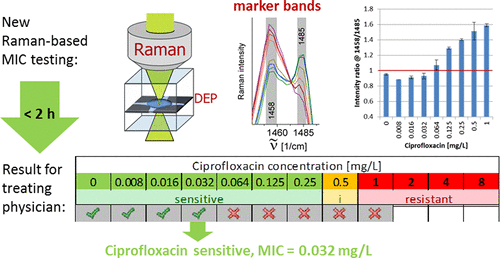当前位置:
X-MOL 学术
›
Anal. Chem.
›
论文详情
Our official English website, www.x-mol.net, welcomes your feedback! (Note: you will need to create a separate account there.)
Simple Ciprofloxacin Resistance Test and Determination of Minimal Inhibitory Concentration within 2 h Using Raman Spectroscopy
Analytical Chemistry ( IF 7.4 ) Pub Date : 2018-01-11 00:00:00 , DOI: 10.1021/acs.analchem.7b03800 Johanna Kirchhoff 1 , Uwe Glaser 1 , Jürgen A. Bohnert 2 , Mathias W. Pletz , Jürgen Popp 1, 3, 4 , Ute Neugebauer 1, 3, 4
Analytical Chemistry ( IF 7.4 ) Pub Date : 2018-01-11 00:00:00 , DOI: 10.1021/acs.analchem.7b03800 Johanna Kirchhoff 1 , Uwe Glaser 1 , Jürgen A. Bohnert 2 , Mathias W. Pletz , Jürgen Popp 1, 3, 4 , Ute Neugebauer 1, 3, 4
Affiliation

|
Resistant bacteria are spreading worldwide, which makes fast antibiotic susceptibility testing and determination of the minimal inhibitory concentration (MIC) urgently necessary to select appropriate antibiotic therapy in time and, by this, improve patient’s outcome and, at the same time, avoid inappropriate treatment as well as the unnecessary use of broad spectrum antibiotics that would foster further spread of resistant bacteria. Here, a simple and fast Raman spectroscopy-based procedure is introduced to identify antimicrobial susceptibilities and determine the MIC within only 2 h total analysis, marking a huge time savings compared to established phenotypic methods nowadays used in diagnostics. Sample preparation is fast and easy as well as comparable to currently established tests. The use of a dielectrophoresis chip allows automated collection of the bacteria in a micron-sized region for high-quality Raman measurement directly from bacterial suspensions. The new Raman spectroscopic MIC test was validated with 13 clinical E. coli isolates that show a broad range of ciprofloxacin resistance levels and were collected from patients with blood-stream infection. Micro-Raman spectroscopy was able to detect ciprofloxacin-induced changes in E. coli after only 90 min interaction time. Principal component analysis as well as a simple computed ratio of the Raman marker bands at 1458 and 1485 cm–1 show a clear concentration-dependent effect. The MIC values determined with the new Raman method are in good agreement with MICs obtained by reference methods (broth microdilution, Vitek-2, E-test) and can be used to provide a classification as sensitive, intermediate, or resistant using the clinical breakpoints provided by EUCAST.
中文翻译:

简单的环丙沙星耐药性测试以及使用拉曼光谱法测定2小时内的最低抑菌浓度
耐药菌正在全球范围内扩散,这使得及时进行抗生素敏感性测试和确定最小抑菌浓度(MIC)迫在眉睫,以便及时选择合适的抗生素治疗,从而改善患者的治疗效果,同时避免不当治疗,以及不必要地使用会促进耐药菌进一步传播的广谱抗生素。在此,引入了一种简单且快速的基于拉曼光谱的方法,以鉴定抗菌药的敏感性并在仅2小时的总分析时间内确定MIC,与如今在诊断中使用的已建立的表型方法相比,可节省大量时间。样品制备快速简便,并且可与当前建立的测试相媲美。介电电泳芯片的使用允许在微米大小的区域自动收集细菌,从而直接从细菌悬液中进行高质量拉曼测量。新的拉曼光谱MIC测试已通过13种临床验证大肠杆菌分离株显示出广泛的环丙沙星耐药水平,并从有血流感染的患者中收集。只需90分钟的相互作用时间,显微拉曼光谱就能检测出环丙沙星诱导的大肠杆菌变化。主成分分析以及在1458和1485 cm –1处拉曼标记带的简单计算比率显示出明显的浓度依赖性效应。通过新的拉曼方法测定的MIC值与通过参考方法(肉汤微稀释,Vitek-2,E-test)获得的MIC高度吻合,并可使用临床断点将其分类为敏感,中间或耐药由EUCAST提供。
更新日期:2018-01-11
中文翻译:

简单的环丙沙星耐药性测试以及使用拉曼光谱法测定2小时内的最低抑菌浓度
耐药菌正在全球范围内扩散,这使得及时进行抗生素敏感性测试和确定最小抑菌浓度(MIC)迫在眉睫,以便及时选择合适的抗生素治疗,从而改善患者的治疗效果,同时避免不当治疗,以及不必要地使用会促进耐药菌进一步传播的广谱抗生素。在此,引入了一种简单且快速的基于拉曼光谱的方法,以鉴定抗菌药的敏感性并在仅2小时的总分析时间内确定MIC,与如今在诊断中使用的已建立的表型方法相比,可节省大量时间。样品制备快速简便,并且可与当前建立的测试相媲美。介电电泳芯片的使用允许在微米大小的区域自动收集细菌,从而直接从细菌悬液中进行高质量拉曼测量。新的拉曼光谱MIC测试已通过13种临床验证大肠杆菌分离株显示出广泛的环丙沙星耐药水平,并从有血流感染的患者中收集。只需90分钟的相互作用时间,显微拉曼光谱就能检测出环丙沙星诱导的大肠杆菌变化。主成分分析以及在1458和1485 cm –1处拉曼标记带的简单计算比率显示出明显的浓度依赖性效应。通过新的拉曼方法测定的MIC值与通过参考方法(肉汤微稀释,Vitek-2,E-test)获得的MIC高度吻合,并可使用临床断点将其分类为敏感,中间或耐药由EUCAST提供。


























 京公网安备 11010802027423号
京公网安备 11010802027423号